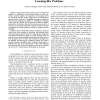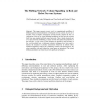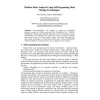909 search results - page 118 / 182 » Introduction to artificial neural networks |
GPEM
2006
13 years 8 months ago
2006
There are various representations for encoding graph structures, such as artificial neural networks (ANNs) and circuits, each with its own strengths and weaknesses. Here we analyz...
CEC
2007
IEEE
14 years 2 months ago
2007
IEEE
— Environments with varying reward contingencies constitute a challenge to many living creatures. In such conditions, animals capable of adaptation and learning derive an advanta...
ECAL
2001
Springer
14 years 14 days ago
2001
Springer
This paper presents recent work in computational modelling of diffusing gaseous neuromodulators in biological nervous systems. It goes on to describe work in adaptive autonomous sy...
GI
1998
Springer
14 years 6 days ago
1998
Springer
"KnowledgeMiner" was designed to support the knowledge extraction process on a highly automated level. Implemented are 3 different GMDH-type self-organizing modeling algo...
ICIP
1994
IEEE
14 years 9 months ago
1994
IEEE
Classical models for motion detection with artificial neural networks are inspired in physiological data of simple visual systems. Local speed estimationis a problem that involves...



